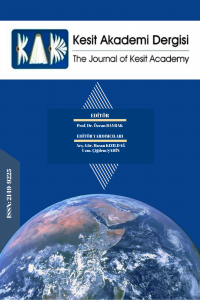RUPERT BROOKE’UN “THE SOLDIER” VE RUDYARD KIPLING’İN “FOR ALL WE HAVE AND ARE” ADLI ŞİİRLERİNDE SAVAŞIN KARANLIK YÜZÜNÜN ARKA PLANDA TUTULMASI
Eski zamanlarda, savaş kültürü vatanseverlik ve savaşta ölmenin şanı üzerine kurulmuştu İngiliz şairlerden Rupert Brooke ve Rudyard Kipling, şiirlerindeki kendine has tarzlarını bir savaş propagandası aracı olarak toplumu manipüle etmek amacıyla kullanmışlardır. Brooke'un “The Soldier” 1914 adlı şiiri, savaşmanın ana vatan için ne kadar kutsal olduğundan ve insanların savaşta öldükten sonra nasıl ödüllendirileceğinden bahsetmiştir. Benzer şekilde, Rudyard Kipling “For All We Have and Are” 1914 adlı şiirinde, askerleri savaşmaya çağırmış, düşmanın yıkıcılığına odaklanmış ve İngiltere'nin kendisini karşısındaki yıkıcı düşmandan korumaya ihtiyacı olduğunu vurgulamıştır. Bu çalışma, her iki şairin de vatan için mücadele adı altında, şiirlerinin arka planındaki karanlık sonuçları gizleyerek ne şekilde savaş propagandası yaptıklarını incelemeyi amaçlamaktadır.
Anahtar Kelimeler:
1. Dünya Savaşı, Şiir, Propaganda, Rupert Brooke, Rudyard Kipling
KEEPING THE DARK SIDE OF THE WAR IN THE BACKGROUND IN RUPERT BROOKE’S “THE SOLDIER” AND RUDYARD KIPLING’S “FOR ALL WE HAVE AND ARE”1
In the earlier stages, the war culture is predicated on patriotism and the glory of dying in the battle. British poets Rupert Brooke and Rudyard Kipling employed their unique voice in their poetry as an instrument of war propaganda to manipulate the society. The poem “The Soldier” 1914 by Brooke carries the idea of how divine it is to fight for the motherland or how people will be rewarded after they die in the war. Similarly, Rudyard Kipling calls soldiers to fight, focuses on the destructiveness of the enemy and create the sense of that England need to protect itself from this devastating enemy in his poem “For All We Have and Are” 1914 . This study aims to analyse how both poets employ war propaganda in disguise of fighting for the nation, while they hide the dark consequences of the war in the background of their poetry.
Keywords:
The Great War, Poetry, Propaganda, Rupert Brooke, Rudyard Kipling,
___
- Amis, K. (1975). Rudyard Kipling and his world. London: Thames & Hudson.
- Gifford, D. (1995). Soldier Poets (1914-1918). Hungarian Journal of English and
- Greenblatt, S., Christ, C. T., David, A., Lewalski, B. K., Lipking, L., Logan, G., . . . Abrams, M. H. (2012). The Norton Anthology of English Literature (9th ed.). W. W. Norton & Company.
- Kendall, Tim. Poetry of the First World War: An Anthology. Oxford University Press, 2013.
- McLoughlin, K. (2009). The Cambridge Companion to War Writing. Cambridge: Cambridge University Press.
- Musolff, Andreas. “Wilhelm II’s ‘Hun Speech’ and Its Alleged Resemiotization During World War I”.
- Phillips, A. (2006). The Penguin Freud Reader. London: Penguin Classics. American Studies (HJEAS), 1(2), 47-63. Retrieved from http://www.jstor.org/stable/41273896
- Shaw, B. (1906). The Devil’s Disciple: A Melodrama. New York: Brentano’s Publishers.
- Walter, George. The Penguin Book of First World War Poetry. Penguin Group, 2006.
- Ragen, Brian Abel. “‘The Hun is at the Gate’: Rudyard Kipling’s Poetry of the First World War,”
- Poetry and History Conference, the University of Stirling, Scotland, June 1996. https://www.brianbaleragen.net/The-Hun-is-at-the-Gate.pdf
- Hall, S. (1920). A General Introduction to Introduction to Psychoanalysis. New York: Boni and Liveright.
- Renshaw, A. (2014). Wisden on the Great War: The Lives of Crickets Fallen 1914-1918. London:John Wisden and Co, an imprint of Bloomsbury Publishing Plc.
- Başlangıç: 2015
- Yayıncı: Asos Eğitim Bilişim Danışmanlık San. Tic. Ltd. Şti.
Sayıdaki Diğer Makaleler
HÜSEYİN ÂLÎ EFENDİ VE RİYÂZÜ’T-TERÂCİM ADLI BİYOGRAFİK ESERİ
ORHAN HANÇERLİOĞLU’NUN “TOPRAK” ADLI HİKÂYESİNDE TEMSİLÎ ANLATI ve “MİMESİS”
ÇEVRE DOSTU TARIM UYGULAMALARININ VAZGEÇİLMEZİ OLAN BİYOGÜBRE ÜRETİM FAALİYETLERİNE GÖNEN ÖRNEĞİ
YEHOVA ŞAHİTLERİ VE TÜRKİYE'DEKİ MİSYONERLİK FAALİYETLERİ "ANTALYA ÖRNEĞİ
ÇOK KRİTERLİ KARAR DESTEK YAPISINDA KONJOİNT ANALİZİ: ÜNİVERSİTE TERCİH ÖRNEĞİ
Mehmet Can HANAYLI, Özel SEBETCİ
GÜZEL SANATLAR VE TASARIM FAKÜLTESİ ÖĞRENCİLERİNİN “SANATÇI” KAVRAMINA İLİŞKİN ZİHİNSEL İMGELERİ
CUMHURİYETİN İLK YILLARINDA EĞİTİM VE KÜLTÜR KURUMLARI 1923-1938 YILLARI ARASI
